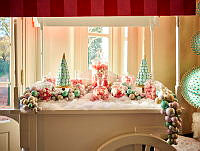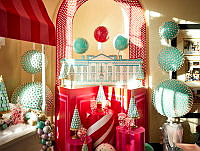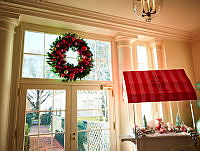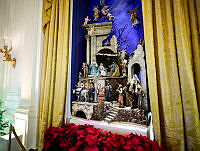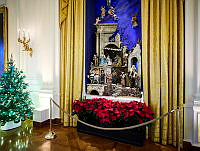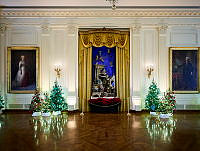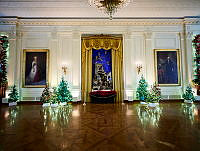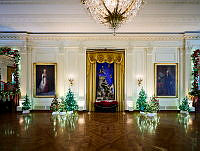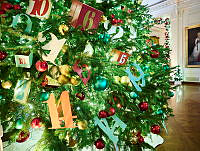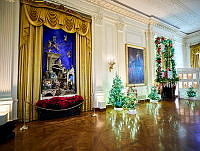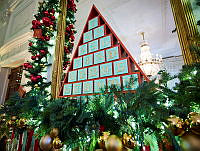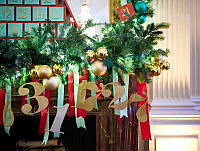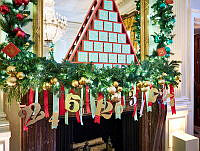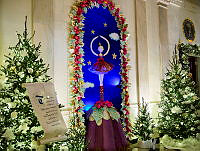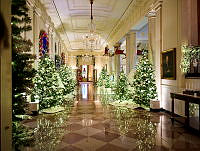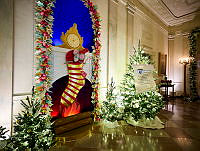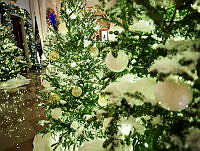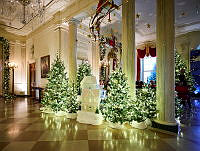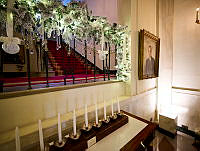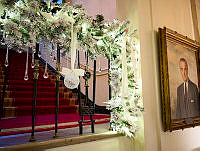Official White House China: From the 18th to the 21st Centuries
Introduction
Copyright © Summer 2016 White House Historical Association. All rights reserved under international copyright conventions. No part of this article may be reproduced or utilized in any form or by any means, electronic or mechanical, including photocopying, recording, or by any information storage and retrieval system, without permission in writing from the publisher. Requests for reprint permissions should be addressed to books@whha.org
The house in which the President of the United States lives has always had a great fascination for American citizens who have come to feel they share in the ownership of the Executive Mansion. Throughout its more than 200 year history, the style in which the house is furnished has been determined—to varying degrees—by the money appropriated by Congress from public funds. Small wonder that the citizens have considered the President’s House their own and have taken such a great interest in its furnishings. It is only since the 1960s that private donations have substantially influenced the style in which the house is furnished.
Beginning with the day President John Adams first moved into the new house at 1600 Pennsylvania Avenue, the fortunate few invited to dine have shared their impressions with family, friends, and neighbors back home. Because hospitality is so bound up in ceremonial eating and drinking, such accounts often include some description of the type of food served and the manner and ware in which it is presented. This interest in food and the dishes of the Executive Mansion has been an inspiration for the formal collection of the White House china itself.
In the beginning of the White House story, it was Congress that made it possible for the public to acquire articles used in the President’s House. The act of March 3, 1797, which granted John Adams funds to furnish the President’s House, also allowed him to sell things that were worn out, out of style, or unusable. The proceeds could be put towards a so-called “furniture fund,” and the sales, often in the form of a public auction, gave the public a chance to buy the White House furnishings acquired with public funds.
By the middle of the nineteenth century, china was sought after at these auctions and cherished for generations by the families who acquired it, but often the purchasers knew little about the history of their prized possessions. The lack of mobility of nineteenth-century Americana resulted in a heavy concentration of these early collections in the Washington area.

This cabinet in the China Room contains the personal services of President George Washington and President John Adams.
White House Historical AssociationIn 1876, for the first time, presidential china privately collected from White House sales was resold at an auction. The printed catalog published for the sale of the “Governor Caleb Lyon Collection of Oriental and Occidental Ceramics” by the Henry D. Miner gallery in New York City listed the available pieces under the heading “Presidential Porcelain” with the explanation, “the following porcelain has been used by the different Presidents and includes specimens from all the sets purchased by Congress at various times to refurnish the White House; some of the Presidents provided their own china or used that which was left by their predecessors in office.” The detailed listings for items numbered 823 to 858 allow us to recognize the known presidential services even though many are misattributed.1 The next published indications of growing public interest in presidential china are two articles written for The Ladies Home Journal in 1889 by Theodore R. Davis, the artist who designed the Rutherford B. Hayes state china.2
The White House staff and first families who sold china apparently did not see the historical importance of the collection, and the proceeds of the sale were likely more important to them than the china itself. It is now known that the china was personally collected at the auctions by White House staff members, and pieces of presidential china turn up with great frequency in the presidential house museums throughout the country.
Caroline Harrison brought a new perspective on the subject when she arrived at the White House as First Lady in 1889. A talented artist accomplished in watercolors and in china painting, Mrs. Harrison had a love of American history, which was politically expedient as her husband had come into office on a platform of “America first,” advocating high tariffs to protect American industry while publicizing the superiority of America’s products. As First Lady, Mrs. Harrison focused her historical interests on the decorative arts objects associated with White House history, and she made a persistent search for furniture, accessories, and other articles associated with the house and succeeded in bringing to light the necessity for their preservation. One of her ambitions was to save for posterity some examples of the presidential china and plates still in the house. She planned to have a cabinet built in the State Dining Room to display the china, and, although she died before she could accomplish this, public interest in the china had been awakened.
The first book to treat the subject of presidential china was China Collecting in America by Alice Morse Earle, published in 1892, which contains a chapter on George and Martha Washington’s china and another on presidential china. It repeats much of Theodore Davis’s 1889 articles, but it is useful for the information it gives on the market value and owners of china at the time.3

Abby Gunn Baker, a journalist and amateur historian, was asked by Colonel Theodore Bingham, the man in charge of public buildings and grounds during the McKinley administration, to write an article on presidential china. Mrs. Baker was deeply involved in the acquisition and preservation of White House China until her death in 1923.
White House Historical AssociationIn 1897, Colonel Theodore A. Bingham became the officer in charge of public buildings and grounds, with responsibility for the care and repair of the President’s House and its contents, and for the preparation of periodic inventories of public property in and belonging to the mansion. In making an inventory in 1901 he found comparatively little china left in the house from previous administrations. Before his appointment, Bingham had served as a military aide in the American embassies in Berlin and Rome, where he was impressed with the care given to royal palaces and their furnishings, and he felt such care was lacking at the White House. During the summer of 1901, Bingham expressed his feelings to Abby Gunn Baker, a journalist who specialized in historical subjects.
He suggested she write a story about the presidential china in the White House in the hope that the resulting attention would lead to its preservation. According to Mrs. Baker, he said that “if somebody does not do that pretty soon, there won’t be any left to preserve.”4 Delighted with the opportunity, she told him that before writing the piece, she would have to study the ware in the house and the records concerning it. Bingham obtained permission from Mrs. McKinley, and Mrs. Baker came to the White House, while the family was away for the summer, and spent the four months studying not only the china in the White House, but also the files of the Treasury Department and other government agencies where pertinent records were kept.
Like all later researchers on this topic, Baker was challenged by the meager details given in the official records. The assassination of President McKinley in September 1901 ended her research, but she had gathered enough material to do the first definitive article ever written on the subject. It appeared in Munsey’s Magazine in December 1903.5 By this time, Colonel Thomas W. Symons had succeeded Bingham as commissioner of public buildings and grounds. Symons showed the Baker article to First Lady Edith Roosevelt and “The White House China Collection” was officially launched. Mrs. Roosevelt, who, like Mrs. Harrison, had always taken a Abby Gunn Baker great interest in American history and felt the obligation of being First Lady keenly, ordered two cabinets to be made for the east end of the lower corridor of the mansion, where they could be seen by visitors. She then had Symons ask Abby Gunn Baker to come to the White House to choose the pieces of china to be displayed in the cabinets. Baker chose examples of the new Theodore Roosevelt dinner service, a few miscellaneous pieces belonging to the McKinley and Cleveland administrations, pieces of the handsome state china designed by Mrs. Harrison, miscellaneous pieces from the Arthur administration, nine pieces of the Hayes service including the turkey platter, pieces of the Grant state china, and six pieces of the Lincoln china. Soon after the china was placed in the cabinets, President Theodore Roosevelt admired the pieces, and enthusiastically directed Symons and Baker to continue to build the collection until it contained some ware representative of every presidential administration.

This dinner plate was purchased during the McKinley administration and features a blue-green border and gilt scrolls. The plate was made by Wedgwood of Etruria, England.
White House Historical AssociationAbby Gunn Baker’s association with the collection continued until her death in 1923. She publicized the search in the public press, descendants of the presidents were contacted, and contributions were sought openly. Nothing was to be bought, for Mrs. Roosevelt’s instructions were that pieces must be either given or loaned. In an effort to form a collection representing every administration, Mrs. Baker and Mrs. Roosevelt accepted china that was privately owned by the earlier presidents as well as that purchased with government funds. Mrs. Roosevelt had the collection designated official government property and placed with other White House furnishings under the care of the commissioner of public buildings and grounds to ensure that it would be a permanent feature at the White House. This was the beginning of the collection displayed in the China Room at the White House today.
A letter written on December 11, 1908, from President Theodore Roosevelt’s personal military aide, Archibald Butt, to his sister-in-law, Clara Butt, gives a glimpse of the china:
I had a rather interesting time the last few days looking over the china at the White House with a view to destroying all that is chipped or broken in any way. Mrs. Roosevelt does not want it sold at auction, for she thinks this method cheapens the White House. I took the matter up with Bromwell [superintendent of public buildings and grounds] who really has it on his papers and is responsible for it, and he thought it ought to be sold and that it should be sold by private bids to cabinet officers and others who are connected with the White House in some way. In former years, it was regarded as the property of the mistress of the White House, who would give it away as she desired but Mrs. R. thinks it should never be given away—and it should not in my opinion for it is government property just the same as the furniture. If it were sold by private bids it would create an awful howl in the press should it become known and so I convinced all concerned that it should be broken up and scattered in the river, which will be done. When I think how I should value even one piece of it, it hurts to smash it, but I am sure it is the only right thing to do. . . . I ran across one plate in a pawnshop the other day which, if I am rightly informed was one of the Grant set. The owner wanted fifty dollars for it. Sloan, the auctioneer tells me that he would be able to get from ten to fifty dollars for every plate which the White House would sell and badly broken pieces would bring something.
The last paragraph of the letter expressed Captain Butt’s idea of involving the Smithsonian Institution in the collection being assembled at the White House:
Mrs. Roosevelt has collected nearly all the china of past administrations which is now in cabinets in the White House. She has had some pieces donated to her and others she has purchased at very high prices. Of course, she paid for them out of the contingent expenses of the White House and they belong to the Government, but if she had not interested herself in collecting what remained of the china of former administrations it is doubtful if it would ever have been done. In order to insure the continuance of their care she has donated them to the Smithsonian Institution, but to be kept in the White House crypt as long as it is desired to have them there. This means that the Smithsonian Institution is responsible for them and takes stock of the collection at regular intervals.6
There is no record of the Smithsonian being offered the collection or the responsibility for it.

This photograph of the China Room was taken in 1918 during the Woodrow Wilson administration. First Lady Edith Bolling Galt Wilson was the first to display the china in this room in 1917 and today every president is represented in the room, though not all designed and purchased a state service during their administrations.
White House CollectionBy the beginning of the Wilson administration, the collection had grown to fill four small cabinets in the downstairs corridor. First Lady Ellen Wilson suggested renovating a Ground Floor room to permanently display the collection, but her death soon after delayed implementation until 1916–17, when the China Room plans were executed with the support of President Wilson’s second wife, Edith.
Following the custom of the Theodore Roosevelt White House, all broken or defaced china had to be condemned, removed from the yearly inventory, and then destroyed. Elizabeth Jaffray, housekeeper from the Taft to the Coolidge administrations, describes accumulated tubs of nicked and broken china, glass, and crystal that were smashed and dumped into the Potomac River so that nothing would fall into the hands of collectors and souvenir hunters. She states that “every year when the inventory has been taken, the broken china and glassware have been destroyed.”7
Pieces of the state services ordered by Presidents Woodrow Wilson, Franklin D. Roosevelt, and Harry S. Truman were added to the White House China Collection as soon as they were received at the White House. Following the renovation of the White House in the spring of 1952, the chinaware of the presidents was reinstalled in new cabinets in the same China Room.
Early in 1955, President and Mrs. Dwight D. Eisenhower and First Lady Mamie Eisenhower selected a set of handsome service plates with a wide gold rim that could be used with any of the other state dinner services. It was the addition of these plates to the china collection and Mrs. Eisenhower’s own love of beautiful china which prompted her great interest in the collection. With the assistance of the Smithsonian Institution, all of the pieces in the White House china collection were carefully examined in 1957, and many of them were relabeled on the basis of research done by the Smithsonian staff.
Because the state china services used during the administrations of Presidents Andrew Johnson, Taft, Harding, Coolidge, and Hoover were purchased during earlier administrations and were more closely identified with other presidents, Mrs. Eisenhower subsequently added to the collection various pieces of personal china used by these presidents.
The interest of the Smithsonian Institution in presidential china began with pieces of china acquired by the Institution in collections of presidential memorabilia. In 1955, this china was exhibited for the first time as a collection in the then newly renovated First Ladies’ Hall in the Smithsonian Institution’s Arts and Industries Building. To classify the pieces and label them for the exhibit, research was necessary. The information gathered also proved valuable when Mrs. Eisenhower wished to improve the exhibition of the china collection at the White House. At her request, curator at the Smithsonian Institution, Margaret Klapthor, spent several weeks at the White House helping to identify and arrange the pieces in the collection. In return, the White House agreed to lend to the Smithsonian Institution pieces of state services not then represented in the museum collection.

Author Martha Brown Klapthor presentis a copy of the first edition of "Official White House China" to First Lady Betty Ford in the White House China Room, 1974.
White House Historical AssociationWhen Jacqueline Kennedy became first lady in 1961, her concern for the house and its furnishings prompted her to establish the position of curator of the White House and to appoint a Fine Arts Advisory Committee to assist her with her plans to restore the furnishings of the White House. At the request of Mrs. Kennedy and her committee, Public Law 87-286 was drafted. The law, approved by Congress on September 22, 1961, provides in Section 2 that:
Articles of furniture, fixtures and decorative objects of the White House when declared by the President to be of historic or artistic interest, together with such similar articles, fixtures and objects as are acquired by the White House in the future when similarly so declared shall thereafter be considered to be inalienable and the property of the White House. Any such article, fixture or object when not in use or on display in the White House shall be transferred by direction of the President as a loan to the Smithsonian Institution for its care, study and storage or exhibition and such articles, fixtures and objects shall be returned to the White House from the Smithsonian on notice by the President.
Under the terms of the law, the president alone has the power to lend items to the Smithsonian Institution or to order their return to the White House.
The early editions of this book were confined to a study of china purchased specifically for the President’s House. With this edition we have added additional references to privately owned china—each of which has a particular reason for being included.

Located on the Ground Floor, the White House China Room, seen here in 2007, has been used since 1917 as exhibition space for White House ceramics, glass, and silver. The painting of First Lady Grace Coolidge has hung in the China Room since 1952.
White House Historical AssociationOur focus on recorded purchases has a second advantage. The vouchers are concrete evidence of many different facets of history. The places of purchase, the types of china being used, the pieces which make up a dinner service and its design, tell much about the material culture and the social customs of our country. The White House was buying the kind of china being purchased for other elegant homes in the United States, and the vouchers which had to be submitted to the Treasury Department offer an excellent opportunity to study a pattern of buying from the end of the eighteenth century to the present day and the changes of taste during the same period.
For the earlier administrations, both the miscellaneous china purchased for general household use and the formal services are listed in some detail in this study, but as soon as the pattern of purchase becomes clear, repetitious details are no longer included. The term “state china” is used to refer to a banquet service purchased for use on state occasions, such as the formal dinners given for members of Congress, foreign diplomats, and heads of states, and any other occasion which calls for a formal meal served in courses.
In addition to a state service, the first lady often purchased less elegant china out of public funds for everyday use. Sometimes the only clue to distinguish between the state china and the less formal china is the number of pieces listed and the price paid for the china.
The term "china," used throughout this book, can be defined as both porcelain and earthenware used for table services at the Executive Mansion. The term acquired this meaning as early as 1889 when Theodore R. Davis wrote his first articles on White House China for The Ladies Home Journal, and it was continued by Abby Gunn Baker and the other writers of the early twentieth century. It is still in use today at the White House where the terms "China Room" and "The White House China Collection" include both porcelain and earthenware used on presidential tables from 1789 to the present.













